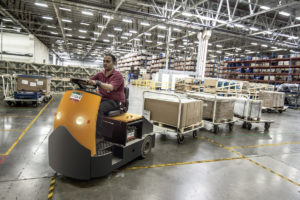 Sometime this year you will most likely be conducting an inventory. Some stores even conduct multiple inventories when they have high stock shortage results. While it does not necessarily translate to poor results, a lack of adequate preparation can have an impact on the final shortage numbers. Occasionally, it is easy to overlook things that can cause an unnecessary stock shortage. Here are some things to look at as you prepare for your next store inventory that may prove helpful in obtaining the best possible results:
Sometime this year you will most likely be conducting an inventory. Some stores even conduct multiple inventories when they have high stock shortage results. While it does not necessarily translate to poor results, a lack of adequate preparation can have an impact on the final shortage numbers. Occasionally, it is easy to overlook things that can cause an unnecessary stock shortage. Here are some things to look at as you prepare for your next store inventory that may prove helpful in obtaining the best possible results:
- If you have shoplifting or employee theft cases you are prosecuting you need to account for the merchandise. A Loss Prevention Department should have an evidence locker with recovered merchandise in it if a case has not come to trial yet. Some police departments retain the evidence and supply a chain of custody form that lists the merchandise they are holding. Ensure the evidence, in either case, is included in your inventory. It may not seem like a lot but if you are the owner of a small or medium retail business a few hundred dollars here and there can be a big deal.
- Look underneath and behind fixtures or cases that may have gaps where merchandise can drop. It does not always occur to people to look under register scan belts but small pieces of merchandise can be pulled in as the belt rolls. Items such as greeting cards and jewelry can find their way underneath and will be missed during a count.
- Check-in desk drawers and in offices for merchandise being used for store purposes. There are at times a need to “store use” merchandise such as pens, trash bags, tape, etc. These should be marked with some type of marker or tag to show that they have been accounted for at some point. If an item is not marked out for store use and is not counted during the inventory process it becomes a shortage.
- Take a look at the sales floor and if your store uses gondolas and shelving for displaying merchandise, lift up baseplates of the gondolas and look for stray merchandise. If you look closely there is a gap between the base of the gondola and the pegboard wall. Small items can find the way down these nooks and crannies. It should also be noted that shoplifters and dishonest employees will hide merchandise under here on occasion.
- If your store sells purses, luggage, diaper bags, etc. unzip them and look inside for merchandise that has been concealed. It is not unusual for a shoplifter to hide merchandise inside and get scared away leaving the hidden items behind.
- If your store sells live units used as displays, be sure they are tagged and ready to be counted. On the flip side of that be sure inactive or non-functional displays are tagged as DNI (Do Not Inventory). These types of displays are often in housewares and may include microwave ovens, blenders, coffee makers, etc. In electronics, it could be a printer, computer, phone and so on.
- Ensure furniture units that may be sold as two separate pieces are counted properly. For example, a desk may have a hutch attached to it on display but the hutch and desk are two unique sku’s.
- Check that all case packs are separated appropriately for sale and counting. For example, I work in a store that sells individual binders and 12 pack cases of binders (each of the binders in the case has a barcode but are intended for sale as part of the case). Be sure your merchandise is counted in the appropriate quantity it is to be sold in.
- Minimize your pre-counts. Some stores will spend an excessive amount of time counting merchandise that they are paying an inventory service to count. These companies are very good at what they do. Have a pre-inventory visit with the representative of the inventory crew and discuss areas that might best be pre-counted but get their input. If they are confident they can count everything allow them to do so. You should be auditing the work on inventory night and catching significant mis-counts.
Hopefully, you have been using Checkpoint equipment to minimize losses due to theft. It is also going to be beneficial to your stock shortage dollars and percent if you have had sound operational plans in place including vendor controls. The last piece to the shortage puzzle is the inventory itself. Follow these suggestions and you can rest easy knowing you have done all you can to improve your chances for a great inventory number for the year.
 In a recent article published in LPM Insider, “Security Footage Sinks Employee Lawsuit Targeting Employee Bag Checks” by Garrett Seivold, Feb 7, 2018, they discussed a lawsuit brought against Nike by an employee who complained that he was being required to have package checks done when he was off the clock. His argument was that he was not being compensated for the time he is delayed. For the time being Nike has not been found to be excessive in its demands. They were able to demonstrate that employees were only being stopped for an average of 18 seconds for an inspection. This is hardly excessive by any measure. However, courts have a tendency to be inconsistent or a higher court may overturn a lower court decision. While one court may uphold the decision in favor of Nike there is no guarantee this will be true should a similar lawsuit be brought against other retailers.
In a recent article published in LPM Insider, “Security Footage Sinks Employee Lawsuit Targeting Employee Bag Checks” by Garrett Seivold, Feb 7, 2018, they discussed a lawsuit brought against Nike by an employee who complained that he was being required to have package checks done when he was off the clock. His argument was that he was not being compensated for the time he is delayed. For the time being Nike has not been found to be excessive in its demands. They were able to demonstrate that employees were only being stopped for an average of 18 seconds for an inspection. This is hardly excessive by any measure. However, courts have a tendency to be inconsistent or a higher court may overturn a lower court decision. While one court may uphold the decision in favor of Nike there is no guarantee this will be true should a similar lawsuit be brought against other retailers.  Many small and big chain businesses across the country are fed up with the amount they lose due to shoplifting and employee theft.
Many small and big chain businesses across the country are fed up with the amount they lose due to shoplifting and employee theft. I recently read an article entitled “How to spot a liar in your inbox” by Vanessa Van Edwards. The article discussed the nuances of how to tell if someone is lying to you in an email. The writer made some interesting observations on the lack of personal pronouns in the body of an email, inconsistency in tense usage and vague language. It dawned on me that often this is the same thing supervisors handle on a regular basis with employees. Think back to a phone call you have taken from an employee calling out of work. Often the conversation goes something like this, “I don’t feel well, I think I am going to have to call out today.” The employee is using language that does not make sense. They “think” they have to call out. Either they do or they don’t have to call out, the decision is theirs to make. Saying “I think” sounds more like asking permission to call out than making a decision of their own. Avoiding responsibility is one way an employee may try to lie without feeling guilty about it.
I recently read an article entitled “How to spot a liar in your inbox” by Vanessa Van Edwards. The article discussed the nuances of how to tell if someone is lying to you in an email. The writer made some interesting observations on the lack of personal pronouns in the body of an email, inconsistency in tense usage and vague language. It dawned on me that often this is the same thing supervisors handle on a regular basis with employees. Think back to a phone call you have taken from an employee calling out of work. Often the conversation goes something like this, “I don’t feel well, I think I am going to have to call out today.” The employee is using language that does not make sense. They “think” they have to call out. Either they do or they don’t have to call out, the decision is theirs to make. Saying “I think” sounds more like asking permission to call out than making a decision of their own. Avoiding responsibility is one way an employee may try to lie without feeling guilty about it. As managers and supervisors, we are all guilty at some point of assuming our employees will know what we are wanting from them when we make a request or assign a project. It may be something as simple as asking someone to empty a trash canister or as complicated as resetting a plan-o-gram. In our minds, the requested task may only require common sense but to the employee, it may be something totally different. Take the trash can example, you may ask an employee to empty it and assumed they would empty it into a compactor and place a new trash can liner inside. The employee may only hear that you want them to take the bag out and place the trash beside the compactor. They don’t hear you tell them to put a new liner inside the canister when they are done because you never said it. It seems like it should only be common sense but it isn’t necessarily the case. The same problem exists for every aspect of a job. Sometimes those of us in management positions make unfair assumptions and then get angry when our team members don’t do what we expected them to do.
As managers and supervisors, we are all guilty at some point of assuming our employees will know what we are wanting from them when we make a request or assign a project. It may be something as simple as asking someone to empty a trash canister or as complicated as resetting a plan-o-gram. In our minds, the requested task may only require common sense but to the employee, it may be something totally different. Take the trash can example, you may ask an employee to empty it and assumed they would empty it into a compactor and place a new trash can liner inside. The employee may only hear that you want them to take the bag out and place the trash beside the compactor. They don’t hear you tell them to put a new liner inside the canister when they are done because you never said it. It seems like it should only be common sense but it isn’t necessarily the case. The same problem exists for every aspect of a job. Sometimes those of us in management positions make unfair assumptions and then get angry when our team members don’t do what we expected them to do. A Target or Walmart store can and are able to fight shoplifting in their stores every day of the year.
A Target or Walmart store can and are able to fight shoplifting in their stores every day of the year. Some of the most stolen items in stores in the United States are not surprising. From Infant formula to razors, people are stealing these items to sell them for quick cash or because they are shoplifters that are dedicated to doing this crime. Valentine’s Day is approaching, and some of the items that seem to be gifted during this day are among the most commonly stolen items in the United States. A shoplifter will steal any time of the year, whether the opportunity presents itself or not, or whether it’s a holiday or a weekday. As a store manager or employee of a store, greeting and treating a customer politely can gain you a customer, and deter a shoplifter from stealing from your store. Customer service has been proven time and again to be a great deterrent to shoplifters, and cannot hurt to be polite and competent with your regular customers.
Some of the most stolen items in stores in the United States are not surprising. From Infant formula to razors, people are stealing these items to sell them for quick cash or because they are shoplifters that are dedicated to doing this crime. Valentine’s Day is approaching, and some of the items that seem to be gifted during this day are among the most commonly stolen items in the United States. A shoplifter will steal any time of the year, whether the opportunity presents itself or not, or whether it’s a holiday or a weekday. As a store manager or employee of a store, greeting and treating a customer politely can gain you a customer, and deter a shoplifter from stealing from your store. Customer service has been proven time and again to be a great deterrent to shoplifters, and cannot hurt to be polite and competent with your regular customers. I actually like and believe in all three of these things. When it comes to drugs they have to be the legal kind. All of us have seen the destruction that illegally used drugs cause. In a business environment, illegal drug use by an employee not only has an impact on their work performance but creates serious customer and legal issues for employers. An employee that is under the influence of any substance that influences their ability to do their job correctly or safely, will cause customers to question who they are doing business with.
I actually like and believe in all three of these things. When it comes to drugs they have to be the legal kind. All of us have seen the destruction that illegally used drugs cause. In a business environment, illegal drug use by an employee not only has an impact on their work performance but creates serious customer and legal issues for employers. An employee that is under the influence of any substance that influences their ability to do their job correctly or safely, will cause customers to question who they are doing business with. Hopefully, your store is one of those places where employees look forward to coming to work. You know what I’m talking about it’s that environment where everyone is happy to be there. Employees know they are there to get a job done and take pride in the service they offer to the customers. It’s the type of job where people may have an off day but their co-workers are supportive and help pick them up. It happens to all of us. These jobs have a manager who interacts with the employees and takes a real interest in each of them. The boss may take time to say hello and greet everyone. They know their employees by name and may even know their families. Unfortunately, not every workplace has such a camaraderie amongst the team members. There is any number of reasons this can happen but a major contributor to an unhappy workplace can be the hiring of an employee with a poor attitude.
Hopefully, your store is one of those places where employees look forward to coming to work. You know what I’m talking about it’s that environment where everyone is happy to be there. Employees know they are there to get a job done and take pride in the service they offer to the customers. It’s the type of job where people may have an off day but their co-workers are supportive and help pick them up. It happens to all of us. These jobs have a manager who interacts with the employees and takes a real interest in each of them. The boss may take time to say hello and greet everyone. They know their employees by name and may even know their families. Unfortunately, not every workplace has such a camaraderie amongst the team members. There is any number of reasons this can happen but a major contributor to an unhappy workplace can be the hiring of an employee with a poor attitude. C
C